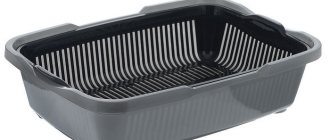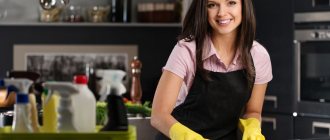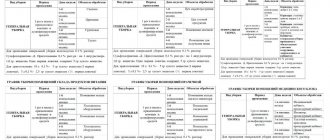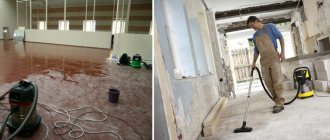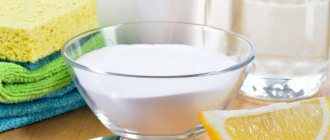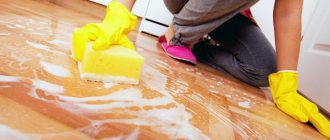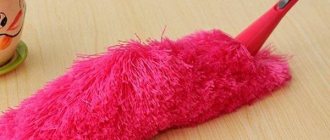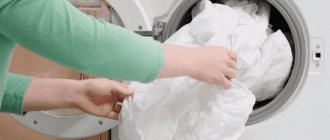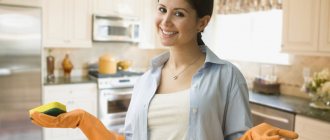Cleaning allows you not only to rid the room of debris and dust, but also to prevent the spread of diseases. The cleaning schedule allows you to organize the cleaning of a specific room and determine the persons responsible for it. Files in .DOC:Room cleaning schedule formSample room cleaning schedule
Monthly cleaning schedule - sample
It is common to keep a cleaning schedule in the form of a table. The columns are numbered in order and signed. Most often, the table contains the following information:
- date of cleaning;
- initials and signature of the performer.
Institutions usually contain additional columns:
- name and concentration of the disinfectant;
- initials and signature of the controlling person.
Sample (blank form):
Organizations must take into account SanPin standards. In beauty salons and medical institutions, 2 types of cleaning are carried out:
- Current. It is carried out twice a day. The last time is always at the end of the working day.
- General. It should be done at least once a week. It is this that must be recorded in the schedule. Sample:
Tables can look completely different. For example, in kindergartens they contain recommendations for cleaning different types of premises:
Other options for blank forms:
Who keeps the journal and why?
The employer has the obligation to comply with sanitary and epidemiological requirements. One of them is keeping cleaning logs to help organize and monitor this work. There are several of them:
- accounting for current cleaning;
- accounting for general cleaning;
- accounting for disinfection.
The management of medical, educational organizations, catering establishments and other public places are required to maintain these documents by sanitary and epidemiological requirements. For each area of activity, a SanPiN has been developed, which contains requirements on the frequency and methods of cleaning, including general cleaning.
In addition, the sanitary and epidemiological rules SP 3.1.3597-20, approved by the Resolution of the Chief Sanitary Doctor No. 15 of May 22, 2020, and Recommendations of Rospotrebnadzor No. 02/3853-2020-27 of March 10, 2020, No. 02/6338-2020-15 dated 04/07/2020, all organizations and entrepreneurs are required to carry out special measures to prevent the spread of coronavirus. These include additional methods and modes of sanitation and disinfection of not only objects, but also air.
Recommendations from Rospotrebnadzor dated September 29, 2020 require that enterprises be disinfected every 2 hours and have a supply of disinfectants for at least 5 days. To confirm compliance with these measures, a book of disinfection activities is maintained. It is important that the sample cleaning and disinfection log developed at the enterprise takes into account all methodological recommendations.
Read more: explanation from Rospotrebnadzor on carrying out disinfection measures in office premises, along with instructions on the procedure for carrying out disinfection measures in order to prevent a new coronavirus infection in office premises.
A designated person, whose details are indicated in the document, is responsible for maintaining accounting books for disinfection activities. The responsibilities of this employee are specified in the job description. For violations committed, both this employee and the head of the enterprise are brought to administrative and other types of liability.
How to find out about restrictions and other measures due to coronavirus
ConsultantPlus has collected all the current rules in one review: what is prohibited and what is allowed, whether it is mandatory to wear masks, what support measures are still in effect, and what monetary payments individuals and organizations can still receive. Convenient to keep track of changes. Free access for 2 days.
Monthly apartment cleaning schedule - sample
All apartments differ from each other in the number of rooms, area, content. But most are still similar. To effectively maintain order and cleanliness, you can use the following apartment cleaning schedules:
Work time
The mode in which cleaning will be carried out depends on the availability of free time. To maintain order in the apartment, it is enough to allocate an hour and a half a day. Time-consuming or complex household chores can be moved to the weekend.
Important! If you don’t run your apartment, keeping it clean throughout the week, a thorough cleaning on the weekend will take less effort and will be completed faster.
Time required to complete basic household chores:
| Household responsibilities (in a small family of three to four people living in a medium-sized apartment) | Approximate cleaning time in minutes |
| Mopping floors | 20 |
| Vacuuming | 15 |
| Ironing | 10–15 |
| Cleaning the work area in the kitchen (after cooking) | 5–15 |
| Wiping dust | 5–10 |
| Cleaning the toilet | 3 |
| Washing dishes after one meal | 5 |
If you take on cleaning energetically and don’t get distracted in the process, you can cope with the daily maintenance of order quickly. Only a few household chores (washing windows, washing curtains, cleaning the microwave and refrigerator) will require time or advance preparation. However, these large-scale events are held much less frequently.
Toilet cleaning schedule for a month - sample
It's no secret that the bathroom is just a storehouse of germs. The toilet needs to be cleaned much more often than other rooms, and always with the use of disinfectants. The cleanliness of this room is used to judge the diligence of the housewife, and in institutions the toilet is an image indicator of the company.
The toilet cleaning schedule is based on traffic volume. Different organizations have their own cleaning frequency. In an ordinary family, the toilet is cleaned at least once a week, in offices - at least 2 times a day.
We recommend: How to permanently get rid of dog smell in an apartment - 6 useful tips
Sample schedule for an organization:
Sample for a regular apartment:
Filling samples
An example of a room disinfection log for coronavirus (can be downloaded and used at work):
| Logbook for current cleaning LLC "Ppt.ru" | 08:00 | Reception | Rubbing | "Chloramine-B" 5% | Ivanova | Kuzmina | |
| 2 | 24.01.2022 | 08:20 | Hall | Wet | "Aqua-chlor" 10% | Ivanova | Kuzmina |
| 3 |
And this is an example of a general cleaning (disinfection) schedule:
Another example is general cleaning:
An approximate example of a log for quartzing premises during coronavirus:
Helpful information
The best monthly cleaning schedule is one drawn up individually, taking into account the schedule, the specifics of the company (for catering, a store, a hospital, the requirements are different) or the way of life of a particular family.
The following information will help you draw a schedule yourself and solve the issue of maintaining cleanliness in general:
- Open Microsoft Word. Find the "Insert" tab, click "Table". Create as many rows and columns as needed (you need to think in advance which items are needed). Sign them. Save the file. Click Print. You can take one of the samples presented above as a basis and add it at your discretion.
- When drawing up a schedule for a hospital, school, or kindergarten, you must be sure to rely on the requirements of SanPin.
- If cleaning is complex, involves multiple tasks, or requires the use of specific disinfectants at a certain concentration, you should print a step-by-step guide (plan) on a separate form. For example, it might look like this:
- The cleaning schedule must be realistic, otherwise it will remain on paper. It is better if it contains fewer tasks (provided that this does not contradict the requirements of SanPin).
- The less rubbish there is in a room or apartment, the easier it is to clean it, and the more willing the performers are to carry out their duties. You should throw away everything that is broken, things and furniture that have not been used for a long time.
- To clean less often, you can get miracle technology - an air washer and a robot vacuum cleaner. Microfiber rags, wipes for cleaning windows, and modern household chemicals such as foam for washing carpets and upholstered furniture will be a good help.
Using a cleaning schedule is the easiest way to discipline household members and employees. It can have different cycles, repeat daily, weekly, monthly, every six months, etc. There are a huge number of all kinds of tables and diagrams. It is most convenient for organizations to use a ready-made schedule journal. You can buy it in the stationery department. To maintain cleanliness and order in the house, it is better to use the samples presented above, or draw a table yourself.
We recommend: How much does general cleaning of an apartment, cottage, house cost: what does the price depend on.
Determining the duration of cleaning
When creating a cleaning schedule, you should take into account the time required for the cleaner to carry out individual tasks during one particular cleaning. The main operations performed during cleaning include:
- sweeping;
- washing, moisturizing;
- changing water and cleaning solutions;
- collection of waste from workplaces;
- sorting and placing waste and garbage into containers;
- wiping, sweeping panels, walls, screens, etc.;
- delivery of garbage and waste to the designated place for their collection.
In addition, the responsibilities of the cleaner may include watering flowers, cleaning mirrors, washing window glass, wiping curtain rods, vacuuming coatings, disinfecting, replacing towels, etc. When determining the duration of cleaning, these operations must also be taken into account.
In addition, the following are taken into account:
- type of premises (industrial, office, residential), as well as the approximate amount of waste that is generated in it during the day;
- room area.
Features of journaling during coronavirus
In accordance with the recommendations of Rospotrebnadzor, it is mandatory to draw up a schedule for cleaning and disinfection of premises in connection with the spread of the COVID-19 viral infection. After each cleaning procedure, planned and one-time disinfections are recorded according to this schedule.
Such strict accounting of the activities carried out will allow for systematic prevention of the spread of viral infection. The frequency of disinfection is adjusted depending on the parameters of the room (area, number of visitors) and purpose.
Here is a detailed algorithm for how to fill out a log for cleaning and processing premises during coronavirus:
- First, enter data on the calculation of the need for disinfectants (number of objects, their area, type of treatment, frequency of treatments per month, working concentration of the solution, consumption of the product per 1 sq. m, quantity for one procedure, need for a month and a year).
- Write down information about their receipt (indicating the name of the drug, the date of its delivery, details of the invoice, the quantity of the purchased solution, its expiration date).
- Carrying out preventive disinfection work (name of the object, area, name of the drug, its concentration, amount of solution used).
- Each column contains the signature of the responsible person.
This list of information is the minimum for entering into the table. Each company manager has the right to add the necessary information depending on the specifics of the activity, type of premises, number of employees, visitors, clients.
The rules established by Rospotrebnadzor in connection with the COVID-19 epidemic have led to the maintenance of many additional accounting books. For example, here are the logs you should keep during coronavirus at school:
- on the provision of personal protective equipment (masks and gloves) to employees;
- on cleaning and treatment of premises and surfaces;
- about disinfection of the premises;
- on measuring the temperature of employees, students and visitors;
- on treating workers’ hands with an antiseptic;
- about handling dishes in the dining room;
- about ventilation of classrooms;
- about taking into account the morning filter of children and employees;
- on recording employees with ARVI symptoms.
Zone 1. Entrance, hallway and dining room
This is FlyLady's list. Adapt, change it to suit your needs, the needs of your family, and remember: no cleaning will be effective until you get rid of the trash that surrounds you. Don't overwork yourself! If you're in the process of decluttering, you may not be ready to complete this list yet. BabySteps! FlyLady
List for the hallway:
Start cleaning from top to bottom (i.e. from ceiling to floor)
- Remove cobwebs and clouds of dust from the ceiling
- Wash the window sills and front door
- Clean switches from fingerprints and, if necessary, remove fingerprints from walls
- Rinse the flowers in the shower - this will refresh them. Let them stay there until you're done.
- Remove dust from furniture
- Wash the baseboards
- Put all your clothes back where they belong (in the closet, take them to church, or throw them away)
- Vacuum and/or mop the floors
- Put the flowers back and tidy up - you don't want your DH to end up in the jungle tomorrow morning.
- Add something of your own to make your home better and more welcoming.
List for the dining room (or another room)
Start cleaning from top to bottom (i.e. from ceiling to floor)
- Remove cobwebs and clouds of dust from the ceiling
- Wash the window sills
- Wash the window
- Wash the doors of the cupboard (glass cabinet or cabinet). Don't forget to tidy up the dishes sitting there if necessary.
- Disassemble one of the boxes and/or check the already disassembled boxes
- Wash the dining table thoroughly. A little polish won't hurt.
- Rinse the flowers in the shower.
- Wash the chair legs
- Move the furniture and vacuum underneath it. Just don't touch the buffet! I turned it over once. It wasn't funny at all.
- Add something of your own (a new tablecloth, a cute vase, flowers...)
List for the front door and the space around it (for the lucky owners of private houses: veranda and courtyard)
- Remove cobwebs and clouds of dust (In the summer I don’t remove cobwebs, I feed the spiders LOL)
- Wash the furniture on the veranda (or the bench in the common hallway, or the window on the floor)
- Sweep the floor on the landing (or veranda)
- Throw away any dead plants (leaves are also dead plants)
- Tidy up these indecently shaggy bushes near the entrance
- Replant flowers if necessary (summer only)
- Wipe tables, railings, lamps
- Throw away unnecessary things
- Add something of your own to make your home more welcoming (a wreath for the door, a new mat or a bell)
What to consider during a pandemic
For an uninterrupted educational process at school, it is necessary to constantly carry out prevention against coronavirus - cleaning, disinfecting and treating classrooms and public spaces. To minimize the risk of infection, systematic disinfection procedures and ventilation are necessary.
In order to organize the labor process during the spread of coronavirus infection, the head of an educational institution should determine internal work regulations. It is recommended to issue the following local regulations:
- instructions for disinfection;
- order appointing those responsible;
- logbook for issuing masks and others.
In addition to cleaning, it is necessary to carry out disinfection inside the school building. A special ultraviolet lamp with bactericidal light is suitable for processing. Not only classrooms should be cleaned, but also all auxiliary rooms. And canteens, lobbies and recreation areas, and toilets must be washed and treated with disinfectant after each break.
Personal hygiene rules in the office
The most important thing to protect yourself from infection is to maintain good personal hygiene. If you are working:
- use a medical mask in large crowds of people;
- keep your hands clean, wash them frequently for 30 seconds with soap and water or use a sanitizer;
- Avoid touching your mouth, nose or eyes with unwashed hands;
- regularly clean surfaces and devices that you touch (computer keyboard, office equipment panels, smartphone screen), use regular detergents or special wipes;
- When coughing or sneezing, cover your mouth and nose with disposable tissues and throw them away after use.
Rospotrebnadzor has produced leaflets that are used as visual propaganda tools.
Some enterprises create reminders for employees themselves.
Another wave of coronavirus: what’s happening
Due to the resurgence of the disease, Rospotrebnadzor published new recommendations, and regions began to reinstate restrictions. Monitor changes for free using a special review in ConsultantPlus. One page contains all restrictions, support measures and recommendations for the period of the pandemic.
Zone 4. Master bedroom
This is the list for my bathroom, bedroom and closet. Change it to suit your family's needs. Copy it into your favorite text editor and make the required changes. Then print it out and pin it in your QOL. Until we get rid of the clutter in this area, don't even think about trying to complete this list! You've been surrounded by dirt and clutter for too long, but first you need to work on the clutter. Well, after that, this list will seem like a piece of delicious pie to you. FlyLady
List for the master bathroom:
- Wash the rugs
- Sort out your decorative cosmetics
- Organize all shelves/cabinets
- Wash the shower stall
- Wash the shower door
List for the master bedroom:
- Polish the furniture
- Wipe all horizontal surfaces
- Remove cobwebs and clouds of dust from the ceiling
- Turn over the mattress
- Throw out the trash
- Wash the windows
- Organize the books in the bookcase
- Organize your drawers
- Wash the floor under the bed
List for the dressing room:
- Organize the shelves (don't forget the top ones)
- Place your shoes
- Pack your suitcases
- Wipe down the shoe closet
Cleanliness Diary
The log in which current cleanings are recorded may vary in content. Sometimes it is adapted to the region or area of activity of the organization. But in any case, this type of documentation includes:
- serial number;
- date and time of cleaning;
- type of work performed (object, method, premises);
- name of disinfectants;
- FULL NAME. responsible.
The information is filled in immediately upon completion of the work.
Log of routine cleaning: Sample (Download for free)
You can download a routine cleaning log to your computer or phone completely free of charge.
We offer you 4 options for compiling and filling out the journal. Study each one carefully and decide which sample best suits your organization's needs.
We also include requirements for the sanitary maintenance of premises that everyone should know.
Option 1. To enlarge the picture, click on it
Option 2. To enlarge the picture, click on it
Option 3. To enlarge the picture, click on it
Option 4. To enlarge the picture, click on it
Requirements for sanitary maintenance of premises:
To enlarge the picture, click on it
